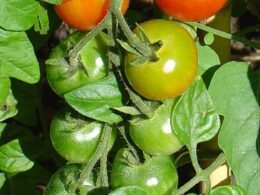You’re nurturing your precious tomato plants, and you notice that they’re starting to bloom. The flowers are beautiful, but you’ve heard that picking them off could potentially help your plant produce more fruit. Should you do it?
In this article, we’ll explore the reasons why some gardeners choose to remove flowers from their tomato plants and guide you through the factors to consider before making your decision. We understand that you want nothing but the best for your little green friends, so let’s dive into a discussion about the proper techniques for removing flowers and potential drawbacks of this practice.
We’ll also explore alternative methods for boosting your tomato plant’s health while ensuring its safety. So sit back, relax, and let us help you make an informed choice that will benefit both you and your beloved tomato plants.
Reasons for Removing Flowers from Tomato Plants
There’s no denying the heartbreak of yanking those lovely blossoms from your precious tomato plants, but sometimes it’s truly for the best. Removing flowers can actually benefit your plants in several ways.
For starters, it allows your plant to focus its energy on developing a stronger root system and sturdier stems instead of producing fruit right away. You might also notice that some of your tomato plants have many flowers at once, which could lead to overcrowded fruits and slow down their growth. By removing some of these blooms, you’re giving the remaining ones a better chance at growing into big, juicy tomatoes.
Additionally, if you live in an area with a short growing season or unpredictable weather conditions, taking off the flowers early on can help ensure that your plant has enough time to produce ripe tomatoes before the cold weather sets in.
So don’t be afraid to give those flower buds a little trim! By doing so, you’re setting up your tomato plants for success and ultimately creating a safer environment for them to thrive in. In turn, this will reward you with plenty of delicious tomatoes come harvest time.
Factors to Consider Before Picking Flowers
Before deciding to pluck those blossoms, consider various factors that could impact your plant’s growth and fruit production.
First, think about the maturity of your tomato plants. If they’re still young and not well-established, removing flowers can help them direct energy towards developing a strong root system and sturdy branches. However, if your plants are already mature and have a solid structure, picking off flowers might be counterproductive as it could reduce the potential harvest.
Another aspect to consider is the specific variety of tomato you’re growing. Some types may benefit from flower removal more than others. For instance, indeterminate varieties continue to grow throughout the season, producing new flowers along the way. In this case, removing early blossoms can boost overall yield by ensuring the plant has sufficient resources for later growth stages. On the other hand, determinate varieties only produce one crop of tomatoes before stopping their growth; hence removing flowers might lead to fewer fruits in total.
Lastly, take into account your region’s climate and growing conditions when making this decision. If you live in an area with a short growing season or unpredictable weather patterns that could affect pollination or fruit development, it might be wise to leave all flowers intact so your plants have every possible chance of producing fruit before frost arrives or adverse conditions set in.
Weighing these factors will help you make an informed decision on whether plucking flowers from your tomato plants is truly beneficial for both you and your garden’s long-term health and productivity.
The Proper Technique for Removing Flowers
Now that we’ve considered the factors, let’s dive into the proper technique for removing flowers from tomato plants, ensuring minimal damage and maximum benefits.
First and foremost, it’s essential to use clean, sharp pruning shears or scissors to avoid transmitting diseases between plants. Make sure you sterilize your tools with a solution of one part bleach to nine parts water before starting.
To remove the flowers safely, carefully hold onto the flower cluster stem with one hand and cut just above where it connects to the main stem with your other hand using your shears. Be gentle as tomato stems can be delicate and easily damaged if handled roughly.
If you see any small fruits developing alongside the flowers, make sure you remove them as well in order for the plant to focus its energy on producing larger tomatoes.
Now that you know how to properly remove flowers from your tomato plants, remember that this process is meant to boost fruit production and overall plant health while reducing potential risks.
Keep an eye on your plants throughout their growth cycle so you can make informed decisions about flower removal based on their needs. By doing so, you’ll be setting yourself up for success in growing healthy and abundant tomatoes – all while keeping your precious plants safe!
Is It Necessary to Remove Tomato Flowers in order to Promote Fruit Growth?
When it comes to tomato plants, it is not necessary to remove tomato flowers to promote fruit growth. In fact, it is recommended to leave stem on tomatoes when you pick them. Removing the flowers can hinder the plant’s ability to produce fruits. So, allow those flowers to develop into delicious tomatoes for a bountiful harvest.
Potential Drawbacks of Removing Flowers
While it may seem beneficial to remove flowers from tomato plants, let’s explore some potential drawbacks that might make you reconsider this practice.
First, removing flowers can reduce the overall yield of your tomato crop. The more blossoms your plant has, the more tomatoes it can potentially produce. By taking away these blooms, you’re limiting the number of fruits your plant will be able to grow.
Another downside is that you might accidentally remove healthy and viable flowers along with the weak ones. It’s not always easy to tell which blossoms are struggling or won’t turn into fruit without careful observation. You could unintentionally hinder your plant’s ability to produce a decent harvest if you’re too aggressive in your removal efforts.
Lastly, over-pruning can lead to stress for your tomato plants, making them more susceptible to diseases and pests. Consistently cutting back on blooms sends a signal to the plant that it should focus on survival rather than fruit production. This extra stress could weaken its defenses against common issues such as blight or aphids.
So before deciding whether or not to remove flowers from your tomato plants, weigh up these potential drawbacks against any benefits and consider how they might impact the health and productivity of your garden.
Alternative Methods for Boosting Tomato Plant Health
Looking for ways to improve your tomato plant’s health? Let’s discuss some effective strategies. These include pruning techniques, proper watering, and fertilization. With these simple methods, you’ll help your plants thrive and produce a bountiful harvest.
Pruning Techniques
It’s essential to understand various pruning techniques to ensure you’re giving those tomato plants the attention they deserve. Pruning promotes healthy growth, increases airflow, and helps prevent diseases.
The two main methods are pinching off suckers and removing lower leaves. Pinching off suckers involves removing the small shoots that grow between the main stem and branches, which allows the plant to focus its energy on producing fruit instead of more foliage.
When it comes to removing lower leaves, this technique not only improves air circulation but also minimizes the risk of soil-borne diseases splashing onto your precious tomatoes. To do this, simply snip off any yellowing or diseased-looking leaves near the base of the plant as it grows taller.
By taking these precautions and learning proper pruning techniques, you’ll be well on your way to nurturing a thriving tomato garden that’s safe from harm and bursting with delicious fruits!
Proper Watering and Fertilization
Now that you’ve mastered pruning, let’s dive into the essentials of watering and fertilizing to keep those tomatoes happy and healthy! Providing your tomato plants with proper care will not only ensure a bountiful harvest but also keep your precious plants safe from potential diseases and pests.
-
Watering: Tomato plants require consistent and deep watering – aim for about 1-2 inches of water per week. Water at the base of the plant, avoiding wetting the leaves, as this can lead to fungal diseases. Be sure to water early in the day so excess moisture can evaporate before nightfall.
-
Fertilization: Tomatoes are heavy feeders, so they need regular applications of fertilizer throughout their growth stages. Start with a balanced fertilizer (like a 10-10-10) when planting, then switch to one higher in phosphorus and potassium once flowers appear (such as a 5-10-10).
-
Mulching: Adding mulch around your tomato plants can help conserve moisture, prevent weeds, regulate soil temperature, and reduce soil-borne diseases. Straw or shredded leaves make excellent mulches; just be sure to avoid piling it against the stems.
By following these simple steps for proper watering and fertilization, you’ll provide your tomato plants with a safe environment in which they can thrive – leading to an abundant harvest that you can enjoy all season long!
Conclusion
So, should you pick the flowers off your tomato plants? It depends on various factors like plant size, stage of growth, and overall health. Weigh the pros and cons before deciding to remove those blooms.
Remember, there are alternative methods for boosting your tomato plant’s health. Keep it simple – give them proper care and enjoy the fruits (or tomatoes) of your labor!









